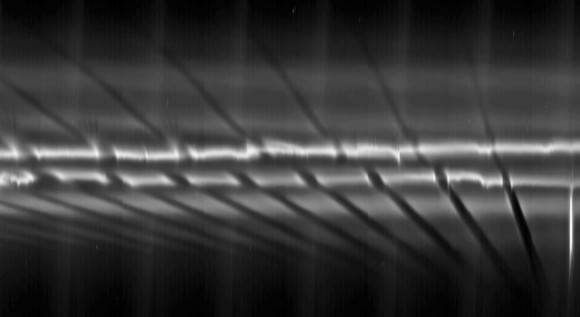[/caption]
I’ve frequently said the Cassini spacecraft is an artist, so when Carolyn Porco, the mission’s imaging team lead, mentioned on Twitter that Saturn’s moon Prometheus is akin to Michelangelo, I had to take a look. Wow, this gorgeous image is suitable for framing! Visible in the perturbed, thin F ring, is the potato-shaped Prometheus, and having performed the perturbing, it continues in its orbit. Click the image for the super-huge version.
Prometheus (148 kilometers, 92 miles across) periodically creates streamer-channels in the F ring, and the moon’s handiwork can be seen as the dark channels. Here’s a movie made from Cassini images showing this process:
The image was taken in visible light with the Cassini spacecraft narrow-angle camera on June 1, 2010. A star is also visible through the rings near the center right of the image.
There are also some additional features in the F ring, courtesy of Prometheus.

This Cassini image shows icy particles in Saturn’s F ring clumping into giant snowballs as the moon Prometheus makes multiple swings by the ring. Scientists say that the gravitational pull of the moon sloshes ring material around, creating wake channels that trigger the formation of objects as large as 20 kilometers (12 miles) in diameter.
“Scientists have never seen objects actually form before,” said Carl Murray, a Cassini imaging team member based at Queen Mary, University of London. “We now have direct evidence of that process and the rowdy dance between the moons and bits of space debris.”
Read more about these fans and snowballs in this JPL article.
Source: CICLOPS


This is pretty stunning, though I am not sure what I am seeing. The moon seems to be approaching the ring in an orbit with a different inclination than the ring. I would then think the moon would pass through or by the ring, rather than dipping back down just after this encounter. Maybe what I am seeing is the “kissing” of the moon orbit with the ring, where both have the same orbital inclination. So my perception is a bit of an illusion.
LC
I’m not sure what I’m seeing, either. But I’m amazed that I’m seeing it at all. It is, indeed, stunning.
A fantastic coincidence of nature! Each time Prometheus reaches the point in its eliptical orbit where it is the furthest away from Saturn, it runs into the F ring.
The apparent up and down movement is an illusion mostly caused by the camera angle, and because the F ring is also eliptical, which makes it look like the moon is moving down as it moves through the F ring.
What’s amazing to me, is the gravitational effect this small moon has within the gravitational pull of Saturn itself. Not just how it makes a mark in the ring, but in seeing the formation of material after it was disturbed.
The moon is in a kissing orbit with the ring. The picture of the streamer channels seems to make that clear. If I assume the moon is made of ice with the density of ice Newtonian gravity gives an acceleration a = GM/r^2 at the surface of the moon equal to a = 1.4cm/s^2. The escape velocity for a particle from the surface is v = sqrt{2GM/r} = 37m/s, which is about the speed of a baseball pitch. So particles in the ring which get close to the moon are gravitationally influenced, particularly since in the frame of the particles the moon is moving pretty slowly.
LC